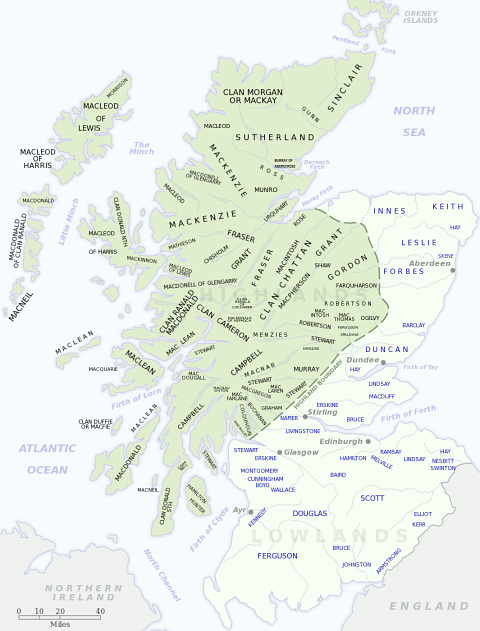
Motto: Spem Successus Alit (Success Nourishes Hope)
Historic Seat: Balnagown Castle
District: Ross-shire
Associated Surnames: Anderson, Andrews, Corbet, Denoon, Enune, Dingwall, Duthie, Fair, Gillanders, Haggart, MacLulich, MacTaggart, MacTear, MacTier, MacTire, Taggart, Train, Vass, Wass, Waters
Associated Tartans:
Early Ross Genealogy and History:
(Excerpt from "The Scottish Clans and Their Tartans", James Grant, 1906)
This tribe is designated by the Highlanders as the Clan Anrias, which is altogether different from their name, as in a similar way, the Robertson's are called the Clan Donnachie. In the ancient genealogical history they are called"Clan Anrias," and it begins with Paul MacTire, to whom William Earl of Ross, Lord of Skye, granted a charter for the lands of Gairloch in 1366, witnessed by Alexander, Bishop of Ross, Hergone, brother of Earl William Henry the Seneschal, and others.
Robertson mentions that in the Earl of Haddington's Collections he met with an entry in the reign of Alexander II, dated about 1220, of a "charter to Ferquhard Ross, of the Earldom of Ross." This Ferquhard, he adds, was called Macant-Sagart, or the Priest's son, and has, with reason, been supposed to be the son of Gille Anrias, from whom the clan took its name.
He founded the Abbey of Fearn, in Ross-shire, in the reign of Alexander II. His son, Earl William, was one of the Scottish nobles who, under Alexander III, bound themselves to make no peace with England in which the Prince and chiefs of Wales were not included. This line ended in Euphemia, Countess of Ross, who became a nun, and resigned the Earldom of Ross to her uncle, John, Earl of Buchan.
The Rosses of Balnagowan were a very ancient line, as they sprang from William, of Earl of Ross, a great patriot and steady friend of Robert I. His son, Earl Hugh, was killed at Halidon Hill,1 fighting for his King and country, in 1333.
The ancient Rosses of Balnagowan failed, and by an unusual circumstance the estate came, by purchase, to another family of the same name, the Lords Ross of Hawkhead, an old and very honourable branch of the clan, which failed on the death of George, twelfth Lord Ross, in 1754, at Ross House, and of his son, the Master, at Mount Teviot, when his title went to the Earls of Glasgow.
The line of Balnagowan is thus given in 1729 by George Crawford, Historiographer for Scotland, and other authorities.
Hugh Ross, second son of Hugh, Earl of Ross, married the heiress of Balnagowan, and was succeeded by William, second Laird of Balnagowan, who married a daughter of the Lord Livingstone. Their son William married Catharine, the daughter of Paul MacTire. She was the heiress of Strathcarron, Strathoykel, and Fostray.
Hugh, third Laird of Balnagowan, married Lady Janet, daughter of the Earl of Sutherland, and had by her John, his heir, and William Ross of Little Allan and Conlnaki, predecessor of the Rosses of Shandwick.
John, fourth of Balnagowan, married a daughter of Torquil MacLeod of the Lewes. Their son Alexander married a lady of the Duffus family, and had "Sir David Ross, who married Helen of Inverugie, daughter to Marishcal's predecessor, by whom he had Walter, his son and heir, and William who was the root of Rosses of Invercharron and its branches. The said Walter married Mary, daughter of James Grant of Freuchy, Laird of Grant."
Their son Alexander was twice married. First, to Jean, daughter of George, Earl of Caithness, by whom he had George, his successor; second to Katherine, daughter of MacKenzie of Kintail, by whom he had a son Nicholas, the first of the line of Pitcalnie. He died in 1591.
George, sixth of Balnagowan, married Marjorie, daughter of Sir John Campbell of Cawdor, with "a tocher of 3000 merks" in 1572. They had a daughter, married to the Laird of Kintoul, and a son, David, seventh of Balnagowan, who by Anne of Tullibardine, had a son, "David the Loyal," who married Mary, Lord Lovat's daughter. He died in Windsor Castle after the Restoration, and Charles II bestowed upon him and his heirs for ever a pension of 4000 merks Scots, yearly.
David, the last Laird of Balnagowan, married Lady Ann Stewart, daughter of the Earl of Murray, and dying without issue, conveyed his estate to Brigadier Charles Ross, son of George, tenth Lord Ross of Hawkhead, by his second wife, Lady Jean Ramsay, daughter to the Earl of Dalhousie.
The Brigadier was an officer of high military reputation, and in 1729 was Colonel of the old 5th Royal Irish Horse raised in 1688, and disbanded after the Rebellion of 1798.
Ross of Pitcalnie is supposed to represent the ancient line of Balnagowan, the present Baronets of Balnagowan being in reality the Lockharts.
In 1745 the fighting force of the clan was 500 men.
The obituary notices for August 1884 contain the death of "Mr George Ross of Pitcalnie, in Ross-shire, and Arnot, in Kincardine, aged eighty-one. Deceased was the last representative of the ancient Earls of Ross, and was chief of the Clan Ross." He was succeeded by a grand-nephew.
(End excerpt)
Next page: Royal Stewart
Footnotes:
1 The Battle of Halidon Hill (1333): The Battle of Halidon Hill was fought on 19 July 1333 during the Second War of Scottish Independence between Scottish forces led by Sir Archibald Douglas and the English forces of King Edward III of England, near Berwick, a disputed territory in the borderlands between England and Scotland. Read more about the Battle of Halidon Hill at Wikipedia.

Distribution of Scottish clans and families
View larger map at Wikimedia Commons

Browse the Clan Ross Hunting Tartan Collection with fabric, home decor, accessories, electronics cases, and more.

Browse the Ross-shire District Tartan Collection with clothing, home decor, accessories, electronics cases, and more.

Clan Ross Postcard: Digitally cleaned and enhanced vintage illustration with tartan border.